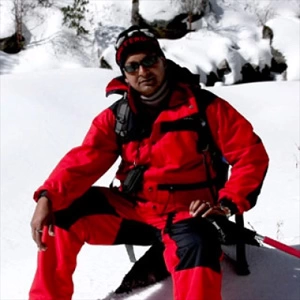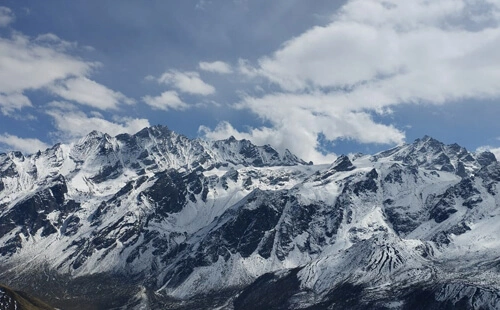Understanding the Annaurna Base Camp Trekking Trail
The Annapurna Trekking Region in Nepal offers multiple easy-to-moderate and challenging Himalayan routes for adventure enthusiasts to choose as per their goals, preferences, and areas of interest. Whether it's the Ghorepani Poon Hill Trek, Khopra Danda Trek, Mardi Himal Trek, Annapurna Circuit Trek, Annapurna Base Camp Trek, or combined Manaslu and Annapurna Circuit Trek, it has something to offer for everyone.
Among all these, the Annapurna Base Camp Trek can span anywhere from about 7 to 14 days based on your pace, fitness level, and itinerary chosen. Nayapul is the typical trek start point and is only a few hours' drive away from Pokhara; hence, it is more accessible than the Everest Base Camp Trek and the Everest Three High Passes Trek, and also the Annapurna Base Camp Trek. The difficulty is moderate compared to the Everest treks.
How difficult is the Annapurna Base Camp?
The level of Annapurna Base Camp Hike Difficulty is regarded as a moderate one. While it does not involve technical climbs and may not require mountaineering experience and skills, to walk 5-7 hours daily for several days, some days including making your way past steep ascents and descents, and to adjust yourself to basic living conditions in the remote Himalayas, a good level of physical fitness and mental determination is a must.
The trail also involves navigating stone steps, forests, and suspension bridges. At 3,000 m above sea level, the level of oxygen drops significantly, and the air is thinner; therefore, proper acclimatization is a must. Like this, there are several factors that determine the Annapurna Base Camp Trekking Difficulty. Follow this guide so your trip is more sorted out, including for beginners, families, and trekkers seeking a private journey.
Major Factors Determining the Annapurna Base Camp Trekking Difficulties
One of the most beautiful treks in Nepal that provides you with the various unique aspects of the Mount Annapurna ranges, like Annapurna I (8,091 m/26,545 ft), Annapurna II (7,937 m/26,040 ft), Annapurna III (7,555 m/24,786 ft), Annapurna IV (7,525 m/24,688 ft), and Annapurna South (7,219 m/23,684 ft). On clear weather days, the trail also gives you glimpses of Gangapurna, Hiunchuli, and Machhapuchhre (Fishtail) from the very beginning.
I.e., the Annapurna Base Camp Trekking route is extremely rich in scenery, and it is culturally and overall one of the most rewarding experiences of life. But like any other high-altitude treks and climbs in the Himalayas, it also comes with some inherent risks that one must not neglect. In winter, cold temperatures can make it really difficult even to move, while in summer/monsoon, slippery and muddy trails can add much to the logistics. In brief:
Trek Annapurna Base Camp Elevation Difficulty
Nayapul is the trek starting point for the Annapurna Base Camp Trek. From around 1,070 m, trekkers gradually ascend up to 4,130 m at base camp, and one of the primary challenges is elevation gain. On rapid ascent without proper acclimatization, there’s a high chance that the body suffers from symptoms of acute mountain sickness (AMS). Less severe compared to the Manaslu Circuit Trek and the Kanchenjunga Base Camps Trek, it can still occur.
The difficulty of the Trek Annapurna Base Camp elevation is that regardless of one’s age, experience, physical fitness, and preparation, you can encounter issues like headache, nausea, dizziness, and vomiting. If it is left uncured for a time, it can take serious forms like HACE and HAPE, which are life-threatening in the lack of immediate medical attention. That is why it is important that you choose itineraries with buffer or acclimatization days.
What is the Annapurna Base Camp Trek duration?
To begin trekking to reach the Annapurna Base Camp, at first, there is a drive from Kathmandu to Pokhara. While you may opt for a short and scenic flight, on a drive it covers 200 km/124.27 miles in about 7-9 hours, and as per trekking distance, it is about 115 km (71.45 miles) to 150 km (93.20 miles) on a round trip from Nayapul to Annapurna Base Camp and back depending on side trips and extended itinerary, if any.
Once the trekking journey begins, you walk 5-7 hours daily, covering 8-12 km (about 5 to 7.45 miles), though it sounds manageable. The steep uphill climbs and downhill walks mean the Annapurna Base Camp Trek distance and duration can significantly influence the overall Annapurna Base Camp trek difficulty level. Especially in high-altitude areas, it can be grueling, and inexperienced trekkers may get anxious.
When is the best Himalayan weather for the Annapurna Trek?
The unpredictable nature of the Himalayan weather is yet another factor that can decide the Annapurna Base Camp Hike difficulty level at the moment. In summer or monsoon seasons, it rains heavily in Nepal, resulting in slippery and muddy trails, sometimes even blocked roads or routes due to floods and landslides, also increasing the Annapurna trek accident rates, while dense snow and cold temperatures are the real deal in winter.
This also answers “Is the Annapurna trek for beginners?” And the answer is yes, especially if you select the right time to go for it, which is in spring and autumn. March to May and September to November are the months with the best Himalayan weather in Nepal. Stable, unlike during summer and winter. The temperature is also mild, the sky is clear, and the trekking trails are also mostly dry, making it a suitable time for beginners.
Is the trekking terrain to the Annapurna Base Camp challenging?
The Annapurna Base Camp hike is famous for its sheer number of stone staircases. The taste of the traditional Himalayan route is steep climbs, and this is after rocky and narrow ledges. These are other real deal and factors that increase the physical challenges of the Annapurna Base Camp trek. From Birenthanti/Nayapul to Ulleri, in the thousands, it can cause joint strains, and those around Chhomrong are relentless.
Balanced by the peaceful forest walking, thrilling crossing of suspension bridges, and stays at teahouses enjoying the warm and genuine hospitality of the Himalayan locals, make sure your trekking boots have good ankle support, use trekking poles, and are physically trained for the stamina required to hike through the stone staircases. Take a break when needed, keep a positive mindset, and take in all that the trek route has to offer.
Can you get private rooms and hot showers during the trek to Annapurna?
Yes, in the lower region, due to the recent addition of roads and improved infrastructure, nowadays trekkers on the trail to reach Annapurna Base Camp can find private rooms with some modern amenities like heating systems, hot showers, complimentary wifi, and also western menus for meals. Otherwise, in the remote Himalayas, accommodations and menus are limited to teahouses with shared rooms and a mix of Nepalese and Tibetan dishes.
For many used to fast-paced urbanization, fast foods, and internet anytime, anywhere, these add to the Annapurna Base Camp Trekking Difficulties. Even when available, these are at some additional cost; internet connectivity can be spotty, electricity is almost nonexistent at high altitude, and getting a place to rest and food to eat is a privilege itself. However, this Annapurna Base Camp difficulty also provides you with a real Himalayan escape to enjoy.
Is Annapurna Base Camp safe? Who can do this trip?
Yes, with proper precautions, the Annapurna Sanctuary Trek is safe. The Annapurna trek accident rate remains extremely low compared to other high-altitude treks in Nepal in and around mountain ranges measuring 8,000 m above sea level. Especially when done with a well-trained, professional, and licensed guide, such as from Adventure Himalayan Travels and Treks, safety becomes the first priority.
Beginners, experienced people, or families with children and aged members with a good level of physical fitness can complete the Himalayan trip to Annapurna Base Camp, but it is a must that one is healthy and does not suffer from permanent health issues with the heart, lungs, or knees. Before you directly book the high-altitude trekking, make sure to consult with doctors to decide whether you can handle the Annapurna Base Camp trekking challenges.
Things to do to master the Annapurna Base Camp Challenges
There are several things that one can do to successfully make it through any difficulties, including the physical challenges of the Annapurna Base Camp trek. Here are some of the essential safety tips to follow that local-based trekking, climbing, and tour operators with more than two decades of experience recommend. The local guide manages all trekking logistics, including permits, and ensures you have a hassle-free experience from start to end.
- Train early: Begin physical training at least 1-2 months before the official trek departure date. Consider cardiovascular exercises like swimming, running, and cycling. Activities that increase stamina and strengthen your muscles are a must, as is conditioning yourself to high-altitude trekking routes.
- Travel insurance: Comprehensive travel insurance with high-altitude coverage up to 5,000 m above sea level is a must. Make sure the policy includes emergency helicopter evacuation and adventurous activities that you are committing to, and their potential risks to Annapurna Base Camp, as discussed.
- Hire Guide and Porter: For trekking in Nepal, it is mandatory to hire a licensed guide and porters to carry significant weight for you, so you save time and energy and use them instead to immerse yourself in the journey fully. With their expert guidance on trail, instant first aid, and 24/7 customer service are guaranteed.
- Proper acclimatisation: The key to minimizing the altitude-related Annapurna Base Camp trekking difficulties is proper acclimatization before attempting high-altitude areas. Maintain your pace while hiking, listen to your body, follow your guide, eat healthy, rehydrate yourself, and most importantly, hike up and sleep low.
- Pack Light and Smart: Trekking gear and equipment lists should include only those absolute essentials. Leave unnecessary things behind in Kathmandu, while three layers of clothing, trekking boots, hiking poles, and first aid kits are basic, and sleeping bags are integral in the upper Himalayas and at night.
Conclusion
Yes, trekking to Annapurna Base Camp is challenging; however, it is manageable and incredibly rewarding, making it a perfectly balanced adventure. Anyone with a good level of physical fitness, preparation, and assistance from an experienced guide can conquer the physical challenge of Annapurna Base Camp and other issues that may arise during the journey. Infrstructures are better than in most of the trekking regions of Nepal.
Trails are safe without extreme altitude, high passes, and technical climbs. By respecting the mountain, maintaining your patience, and staying positive, especially when guided by government-licensed local guides, the difficulty level of the trek to Annapurna Base Camp, including the Annapurna Base Camp elevation difficulty, not only decreases, but the success rate also increases. Contact us now, hire from us, or enjoy our full package.




